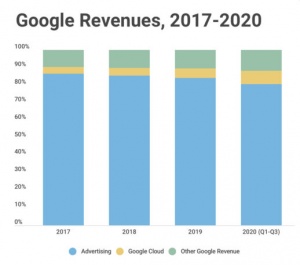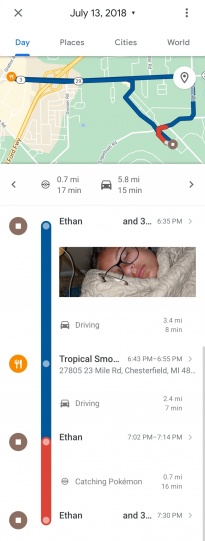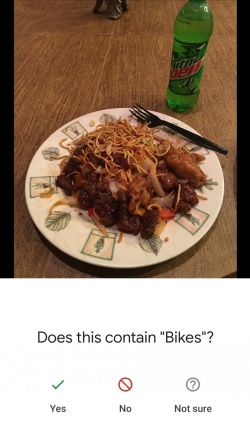Difference between revisions of "Google Photos"
m |
(Added whole section on facial recognition racism) |
||
| Line 43: | Line 43: | ||
===Racism in Facial Recognition=== | ===Racism in Facial Recognition=== | ||
| + | Facial recognition technology is often under scrutiny due to its imbalance racially.<ref>Garcia, Megan. (2016). [https://muse.jhu.edu/article/645268 "Racist in the Machine: The Disturbing Implications of Algorithmic Bias"]. ''Project Muse'' Retrieved March 19, 2021.</ref> Though the accuracy of facial recognition softwares largely depends on the application that uses the technology and the data used to train the algorithm, the majority of the algorithms currently implemented exhibit gaps between the algorithm's ability to match two images of the same person depending on the demographic group.<ref>Boutin, Chad. (2019, December 19). [https://www.nist.gov/news-events/news/2019/12/nist-study-evaluates-effects-race-age-sex-face-recognition-software "NIST Study Evaluates Effects of Race, Age, Sex on Face Recognition Software"]. ''National Institute of Standards and Technology''. Retrieved March 19, 2021.</ref> Study conducted by the National Institute of Standards and Technology's [https://www.nist.gov/programs-projects/face-recognition-vendor-test-frvt Face Recognition Vendor Test (FRVT) Program] found five broad findings<ref>Grother, Patrick. Ngan, Mei. Hanaoka, Kayee. (2019, December). [https://nvlpubs.nist.gov/nistpubs/ir/2019/NIST.IR.8280.pdf "Face Recognition Vendor Test (FRVT)Part 3: Demographic Effects"]. ''National Institute of Standards and Technology''. Retreived March 19, 2021.</ref>: | ||
| + | # Higher rates of false positives for Asian and African American faces relative to images of Caucasians when matching photos one-to-one. | ||
| + | # For algorithms developed in the United States, similar high rates of false positives were found for Asians, African Americans and native groups. | ||
| + | # Some facial recognition algorithms developed in Asian countries experienced no dramatic differences in false positives in one-to-one matching between Asian and Caucasian faces. | ||
| + | # When one-to-many was tested, NIST found higher rates of false positives for African American females. | ||
| + | # For one-to-many matching, not all algorithms gave high rates of false positives across demographics. | ||
| + | It’s important to note that different algorithms show different performances. Studies that have utilized both facial recognition algorithms and facial capture technologies noted that they both work more effectively on white subjects than subjects from other racial groups.<ref>Skinner, David. (2018, October 4). [https://www.tandfonline.com/doi/full/10.1080/09505431.2018.1523887 "Race, Racism and Identification in the Era of Technosecurity"]. ''Science as Culture Volume 29''. Retrieved March 19, 2021.</ref> | ||
| + | Google Photos was also under criticism due to its facial recognition software’s questionable classification. Back in 2015, Jacky Alcine found out that he and his friend, both African Americans, were classified as “Gorillas” by Google Photos’ facial recognition software.<ref>Mullen, Jethro. (2015, July 2). [https://www.cnn.com/2015/07/02/tech/google-image-recognition-gorillas-tag "Google rushes to fix software that tagged photo with racial slur"]. ''CNN''. Retrieved March 19, 2021.</ref> In response to Alcine’s tweet, a senior engineer at Google, Yonatan Zunger, expressed his panic and promised a fix as soon as possible. Google then removed all labels related to primates such as gorillas, chimpanzees and monkeys as an immediate fix.<ref>Hern, Alex. (2018, January 12). [https://www.theguardian.com/technology/2018/jan/12/google-racism-ban-gorilla-black-people "Google's solution to accidental algorithmic racism: ban gorillas"]. ''Guardian''. Retrieved March 19, 2021.</ref> Google have also stated that they were working on a long-term improvement in labeling photos and its image recognition softwares. | ||
===Geotagging=== | ===Geotagging=== | ||
Revision as of 09:01, 19 March 2021
Google Photos is a photo and video storage and sharing service developed by Google. Google Photos was released in May 2015 as it separated from Google’s former social network, Google+.[1] Google says it designed Google Photos with the intent of creating a platform that allows people to store and easily access all of their pictures and videos from any device.[2]
After its release, the size of Google Photos's user base skyrocketed to 200 million after one year, 500 million after two years, and surpassed 1 billion after only four years.[3] As of 2020, Google reports that about 28 billion photos and videos are uploaded every week and that the service is home to more than 4 trillion photos to date.[4]
Contents
Features
Google Photos has apps for Android and iOS, in addition to a website.[5] Photos and videos can be uploaded and accessed via any of these platforms.[6]
The service also organizes photos and videos by identifying any number of features present in the photo such as lakes, night, birthday, and much more.[5] It is also capable of organizing photos by the faces of people and pets in them, even as the faces age.[6][5] Users can manually fix or remove incorrect labels.[6]
Google Photos also can group photos and videos by location.[6] It can determine a photo's location either by its embedded geotagging data, or by analyzing the photo for major landmarks (such as the Eiffel Tower).[6]
Additionally, the service includes a native photo and video editing software that can be used on any platform.[7]
Google Photos offers a variety of ways to make sharing photos and videos easy and simple. One method that Google Photos offers is generating web links that both users and non-users can access.[6] Google Photos also allows users to share albums with someone directly via their Google account.[8]

A heat map feature that displays the concentration of photos in the library as a function of location was added in 2020.[10]
Storage
Photos and videos are each uploaded to Google Photos in one of three ways: "original quality", "high quality", or "express".[11] "Original quality" uploads maintain their original resolution and use part of the associated Google account's 15GB of storage shared between all Google products (including Gmail, Google Drive, etc.).[11] Meanwhile, "high quality" uploads have their resolution downgraded to 16 megapixels and 1080p.[11] Finally, "express" uploads are compressed to 3 megapixels and 480p.[11] The free tier of Google Photos allows unlimited uploads in resolutions up to "high quality."[11]
In November 2020, Google announced that, starting June 1, 2021, Google Photos will no longer offer free unlimited storage at "express" or "high quality."[12] Existing photos and videos will remain unaffected.[4] After all 15GB of account storage have been used, users will either have to maintain a Google One subscription or upload from a Google Pixel 5 device or earlier make.[13][11] Future Pixel devices will be unable to upload in "high quality" for free.[14] This is being done in an effort to increase the number of Google One subscriptions and reduce Google's reliance on ad-based revenue.[9]
Motivations
There is much speculation as to why Google released this product in the first place. Some speculate this was in the interest of getting a foothold in the landscape of personal data in the form of visual imagery.[15] Meanwhile, others say it was intended as a method of outsourcing work to train their visual recognition algorithms: the app frequently asks its users to manually verify (or reject) its proposed tags.[16] To the right is an example of a recognition by Google Photos gone wrong.
Ethical Implications
Security
An obvious concern for a product like Google Photos is users' privacy and the security of their photos and videos from other individuals, third party institutions, and even the government.[17] These concerns are substantiated by occurrences like Google accidentally sending users’ private videos to strangers in November 2019.[18] To alleviate these concerns, Google continuously works to improve its security infrastructure to ensure that the only people that can see an account’s photos is the owner of the account and those that the owner has deliberately shared their photos with.[19]
Computer Vision
Google Photos automatically runs every photo and video through visual recognition algorithms to identify objects and places.[20] And once "face grouping" is turned on by the user, it will also start to group together photos of individual people and pets.[21] Hence, there is cause for concern about Google collecting the information embedded in the photos (including, but not limited to hobbies, family members, pets, and more) and selling it to third parties or using it to display more relevant advertisements.[22] To alleviate these concerns, Google ensures users that "face groups and labels in your account are only visible to you."[21]
Racism in Facial Recognition
Facial recognition technology is often under scrutiny due to its imbalance racially.[23] Though the accuracy of facial recognition softwares largely depends on the application that uses the technology and the data used to train the algorithm, the majority of the algorithms currently implemented exhibit gaps between the algorithm's ability to match two images of the same person depending on the demographic group.[24] Study conducted by the National Institute of Standards and Technology's Face Recognition Vendor Test (FRVT) Program found five broad findings[25]:
- Higher rates of false positives for Asian and African American faces relative to images of Caucasians when matching photos one-to-one.
- For algorithms developed in the United States, similar high rates of false positives were found for Asians, African Americans and native groups.
- Some facial recognition algorithms developed in Asian countries experienced no dramatic differences in false positives in one-to-one matching between Asian and Caucasian faces.
- When one-to-many was tested, NIST found higher rates of false positives for African American females.
- For one-to-many matching, not all algorithms gave high rates of false positives across demographics.
It’s important to note that different algorithms show different performances. Studies that have utilized both facial recognition algorithms and facial capture technologies noted that they both work more effectively on white subjects than subjects from other racial groups.[26]
Google Photos was also under criticism due to its facial recognition software’s questionable classification. Back in 2015, Jacky Alcine found out that he and his friend, both African Americans, were classified as “Gorillas” by Google Photos’ facial recognition software.[27] In response to Alcine’s tweet, a senior engineer at Google, Yonatan Zunger, expressed his panic and promised a fix as soon as possible. Google then removed all labels related to primates such as gorillas, chimpanzees and monkeys as an immediate fix.[28] Google have also stated that they were working on a long-term improvement in labeling photos and its image recognition softwares.
Geotagging
If a user allows Google to keep track of their location history under "Your Timeline" in Google Maps, Google Photos uses this alongside geotags embedded in photos to allow users to search their gallery by location and even review past trips minute-by-minute.[6][29]
Even without geotags, Google Photos is capable of intuiting a photo’s location by analyzing for major landmarks.[6] As a result, concerns have been raised about how this information is used and if it is secure.[30]
Google is upfront that it uses this information to show users more relevant advertisements, but at the same time assures users that this information is never shared with advertisers.[31] Still, to accommodate these concerns, Google Photos gives its users the capability to turn off location history, remove location information from already existing photos, and choose whether or not to share a photo's location when shared.[32]
References
- ↑ Spradlin, L. (2015, May 24). "An Exclusive Early Look At The New Google Photos App". Android Police. Retrieved March 12, 2021.
- ↑ Amateur Photographer. (2015, June 2). "Google Photos Service Raises Privacy Concerns". Amateur Photographer. Retrieved March 12, 2021.
- ↑ Porter, J. (2019, July 24). "Google Photos passes the 1 billion users mark". The Verge. Retrieved March 12, 2021.
- ↑ 4.0 4.1 Ben-Yair, S. (2020, November 11). "Updating Google Photos' storage policy to build for the future". Google | The Keyword. Retrieved March 12, 2021.
- ↑ 5.0 5.1 5.2 Kastrenakes, J. (2015, May 28). "Google announces unlimited picture and video storage with new Photos app". The Verge. Retrieved March 12, 2021.
- ↑ 6.0 6.1 6.2 6.3 6.4 6.5 6.6 6.7 Mossberg, W. (2015, June 2). "The New Google Photos: Free at Last, and Very Smart". Vox. Retrieved March 12, 2021.
- ↑ Lowensohn, J. (2015, May 28). "Hands-on with Google's new Photos service". The Verge. Retrieved March 12, 2021.
- ↑ Mathur, S. (2020, May 19). "New controls for how you share albums in Google Photos". Google | The Keyword. Retrieved March 12, 2021.
- ↑ 9.0 9.1 Newman, J. (2020, November 28). "The end of unlimited Google Photos storage is part of a bigger pivot". Fast Company. Retrieved March 12, 2021.
- ↑ Newton, C. (2020, June 25). "Google Photos gets a map view as part of a big new redesign". The Verge. Retrieved March 12, 2021.
- ↑ 11.0 11.1 11.2 11.3 11.4 11.5 Google. (2021). "Choose the upload size of your photos & videos". Google Photos Help. Retrieved March 12, 2021.
- ↑ Bohn, D. (2020, November 11). "Google Photos will end its free unlimited storage on June 1st, 2021". The Verge. Retrieved March 12, 2021.
- ↑ Google. (2021). "Storage changes for Google Photos". Google Photos Help. Retrieved March 12, 2021.
- ↑ Coberly, C. (2020, November 12). "Future Pixel phone owners may not retain unlimited Google Photos storage access". TechSpot. Retrieved March 12, 2021.
- ↑ Lomas, N. (2015, June 1). "Google Photos Reminder: Smile, It's Free - You're The Product!". TechCrunch. Retrieved March 12, 2021.
- ↑ Perrigo, M. (2020, November 9). "Google Photos wants you to answer questions to help improve its image recognition capabilities". Chrome Unboxed. Retrieved March 12, 2021.
- ↑ Hill, S. (2015, June 16). "Google Photos: Should you be worried about privacy?". Android Authority. Retrieved March 12, 2021.
- ↑ Warren, T. (2020, February 4). "Google admits it sent private videos in Google Photos to strangers". The Verge. Retrieved March 12, 2021.
- ↑ Google. (2021). "Google Photos Safety & Privacy Features". Google Safety Center. Retrieved March 12, 2021.
- ↑ Google. (2021). "Get started with Google Photos". Google Photos Help. Retrieved March 12, 2021.
- ↑ 21.0 21.1 Google. (2021). "Search by people, things & places in your photos". Google Photos Help. Retrieved March 12, 2021.
- ↑ Luckerson, V. (2017, May 25). "Why Google Is Suddenly Obsessed With Your Photos". The Ringer. Retrieved March 12, 2021.
- ↑ Garcia, Megan. (2016). "Racist in the Machine: The Disturbing Implications of Algorithmic Bias". Project Muse Retrieved March 19, 2021.
- ↑ Boutin, Chad. (2019, December 19). "NIST Study Evaluates Effects of Race, Age, Sex on Face Recognition Software". National Institute of Standards and Technology. Retrieved March 19, 2021.
- ↑ Grother, Patrick. Ngan, Mei. Hanaoka, Kayee. (2019, December). "Face Recognition Vendor Test (FRVT)Part 3: Demographic Effects". National Institute of Standards and Technology. Retreived March 19, 2021.
- ↑ Skinner, David. (2018, October 4). "Race, Racism and Identification in the Era of Technosecurity". Science as Culture Volume 29. Retrieved March 19, 2021.
- ↑ Mullen, Jethro. (2015, July 2). "Google rushes to fix software that tagged photo with racial slur". CNN. Retrieved March 19, 2021.
- ↑ Hern, Alex. (2018, January 12). "Google's solution to accidental algorithmic racism: ban gorillas". Guardian. Retrieved March 19, 2021.
- ↑ Bonifacic, I. (2020, December 16). "Google Photos lets you relive a day through your Maps timeline". Engadget. Retrieved March 12, 2021.
- ↑ Komando, K. (2021, January 11). "Hidden map on your phone shows everywhere you’ve been and the photos you took there". USA Today. Retrieved March 12, 2021.
- ↑ Google. (2021). "How Google uses location information". Privacy & Terms. Retrieved March 12, 2021.
- ↑ Google. (2021). "Understand, find and edit your photos' locations". Google Photos Help. Retrieved March 12, 2021.


